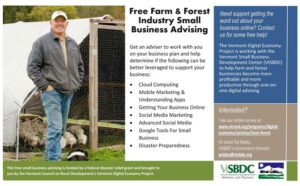One of the reasons I love Vermont is because of its agricultural background. Between the push for a Working Landscape, and the fact that we have the most CSAs per capita anywhere in the United States, Vermont has developed a reputation as a beautiful haven for those who are looking for locally sourced and sustainable food. On the other hand, with help from the Office of the Creative Economy and the Vermont Tech Alliance, Vermont is also well placed to foster entrepreneurship and business growth based around technology. In fact, Burlington was recently named one of the top ten Tech Hubs to watch. Sometimes, these two worlds can seem very far apart, but from our perspective, they can both work together to promote statewide economic development in multiple sectors.
Last Sunday, we participated in the Northeast Organic Farming Association (NOFA) Direct Marketing conference. Two members of the Vermont Digital Economy Project and two volunteers were on hand to offer advice on using social media and digital tools to promote the farmers’ work. Suggestions ranged from using Pinterest to showcase beautiful photos of farm animals and gardens, to finding novel ways to use a curated email list.
What we discovered, both at the NOFA conference and at our panel discussion at the 2013 Summit for Vermont’s Working Landscape, is that often (though not always) the use of digital tools does not come easily to those who work in the Farm and Forest Industries. As Rachel Nevitt explained at our panel discussion, she was dragged, kicking and screaming into the digital world. But at the end of the day, her website helped her find new customers, and it was thanks to her Facebook page that her summer camps were full.
In one way or another, farmers have always been adopting new technologies, from the latest technology in tractors, to the use of an iPhone to get the most up-to-date satellite imagery of the weather. Farmer Richard Oswald describes this immersion in technology particularly well in a piece he wrote for the Daily Yonder, called Letter from Langdon: A Harvest of High-Tech.
One thing that stuck out for Heather Darby, a farmer and professor at UVM Extension, was the way farmers used their mobile phones. “What dawned on me was that farmers have trouble using their computers, but they all know how to use their phone,” she said. So she developed an application, called GoCrop, to help farmers with their nutrient management systems. Other mobile applications, from apps that track field boundaries to apps that allow farmers to keep in touch with each other, show how farmers can use new technology to their advantage.
These examples demonstrate that there are a number of ways that farmers can continue to use existing technology for their own benefit, but we’re also interested in finding new ways to merge technology, agriculture, and forestry, which is why we’re sponsoring a Food Systems Hackathon, in conjunction with the NOFA Winter Conference on February 15. This is our opportunity to bridge what many consider disparate worlds. By having “techies” work with and for farmers, we can demonstrate, in real terms, how these two groups can come together and help each other. In fact, we’re looking for your input. We’re very much looking forward to participating!
We’re also here to help. Through our grant, we are providing business advising, including advising on digital skills, to businesses across the state, and we want to help members of the farm and forest industries get the skills they need.

